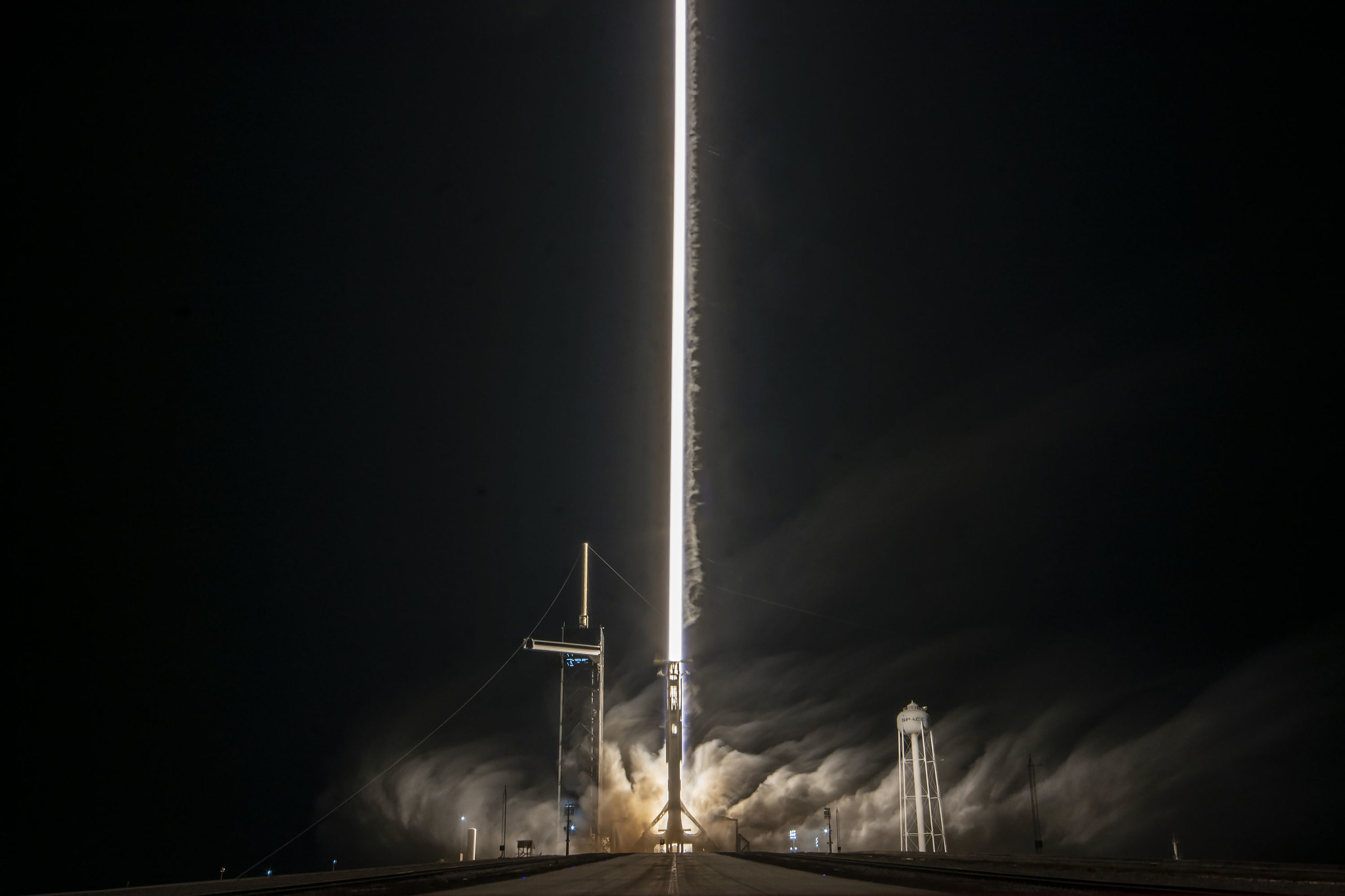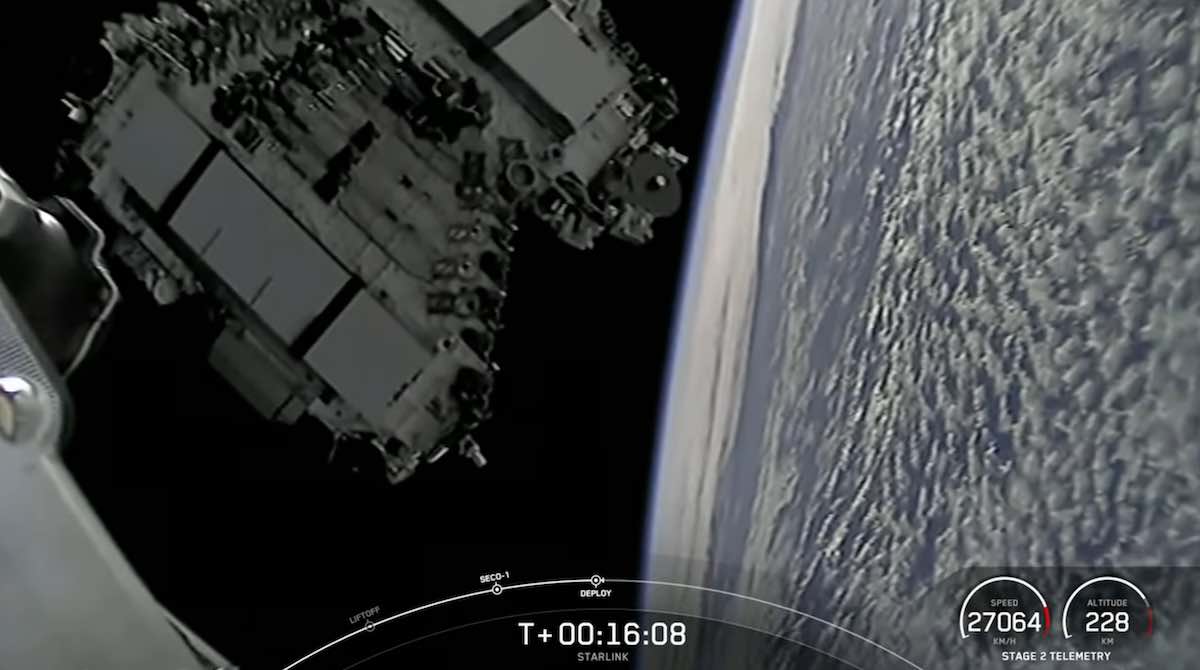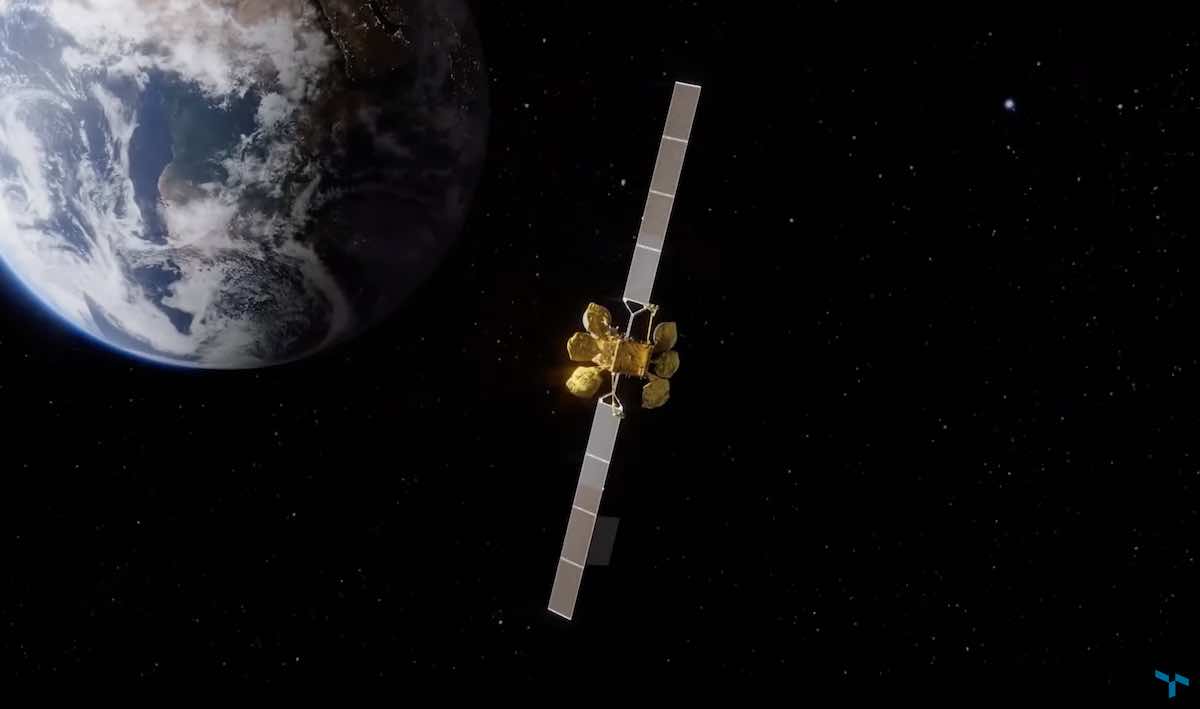Space News & Blog Articles
SpaceX to close out year with surge of launches
 A Falcon 9 rocket streaks off its launch pad in Florida in this long exposure photo. Credit: SpaceX
A Falcon 9 rocket streaks off its launch pad in Florida in this long exposure photo. Credit: SpaceX
SpaceX is set to close out the year with three Falcon 9 rocket flights in just four days from launch pads in Florida and California, carrying another batch of Starlink internet satellites, a Turkish data relay spacecraft, and a resupply mission to the International Space Station.
The missions will blast off from each of the company’s active orbital launch pads at Vandenberg Space Force Base, Cape Canaveral Space Force Station, and Kennedy Space Center.
If SpaceX pulls off all three launches by the end of the year, the company will wrap up 2021 with 31 Falcon 9 rocket flights. SpaceX has already exceeded its previous record of 26 Falcon 9 launches in a calendar year.
The first of the three upcoming missions is set for blastoff from Vandenberg, a military spaceport on California’s Central Coast between Los Angeles and San Francisco. A Falcon 9 rocket will take off from Space Launch Complex 4-East with another group of satellites for SpaceX’s Starlink internet network.
SpaceX has not officially confirmed the launch schedule, but airspace and maritime warning notices released earlier this week show the mission is scheduled for early Friday. SpaceX also releases predicted orbit data before Starlink launches as a courtesy to help space traffic managers and other satellite operators know the expected locations of the newly-launched internet spacecraft.
That information suggests the mission will launch from Vandenberg at 1:46 a.m. PST (4:46 a.m. EST; 0946 GMT) Thursday, carrying 52 more Starlink internet satellites into an orbital plane tilted at an Ange of 53.2 degrees to the equator.
CelesTrak has pre-launch SupTLEs for #Starlink Group 4-4, which is set to launch 2021-12-17 09:46:20 UTC on a Falcon 9 rocket from Vandenberg AFB, California. Deployment of 52 satellites occurs just over 15 minutes later at 10:01:56.540 UTC: https://t.co/J39z8yvPdD. pic.twitter.com/LRNoDW3kO2
— T.S. Kelso (@TSKelso) December 15, 2021
The mission is designated Starlink 4-4, and the rocket will follow an unusual southeast trajectory from Vandenberg, hugging the coastline of Baja California on the way into orbit.
Around 15 minutes after liftoff, the rocket’s second stage will deploy the 52 Starlink satellites into an elliptical transfer orbit stretching as high as 212 miles (341 kilometers) above Earth, while the first stage booster will target a landing on SpaceX’s drone ship “Of Course I Still Love You” parked in the Pacific Ocean around 400 miles downrange.
The 52 satellites will use krypton-fueled ion thrusters to maneuver into their operating orbits at an altitude of 335 miles (540 kilometers), joining the rest of the Starlink fleet providing global internet service. With the next batch of satellites, SpaceX will have launched 1,944 Starlink spacecraft since May 2019.
A tabulation maintained by Jonathan McDowell, an astrophysicist and widely-respected tracker of spaceflight activity, shows that SpaceX currently has 1,729 functioning Starlink satellites in orbit. Of those, 1,467 satellites are operational, while the rest are still maneuvering into their slots in the constellation, or are otherwise working but not providing internet service.
SpaceX does not publish details about which of its Starlink satellites are operational, leaving outside experts like McDowell to gather and disseminate the information.
Jonathan Hofeller, SpaceX’s vice president of Starlink and commercial sales, said Tuesday that the Starlink network is providing internet service to consumers in more than 20 countries.
“We have well over 100,000 subscribers, both on the consumer and enterprise sides,” he said in a panel discussion at Euroconsult’s annual World Satellite Business Week event in Paris. “And we’re not slowing down. We’re just getting warmed up.”
 This view from a previous mission shows a batch of Starlink internet satellites separating from a Falcon 9 rocket in orbit. Credit: SpaceX
This view from a previous mission shows a batch of Starlink internet satellites separating from a Falcon 9 rocket in orbit. Credit: SpaceX
SpaceX has a long-term plan to launch as many as 42,000 Starlink satellites, according to a company filing with the International Telecommunication Union. The company’s initial focus is on deploying around 4,400 satellites into five orbital “shells” at different inclinations.
The five Starlink orbital shells are all located between 335 and 348 miles (540 and 560 kilometers), at inclinations of 53, 53.2, 70, and 97.6 degrees. SpaceX completed launches into the 53-degree orbital shell in May, and started launching satellites into a 70-degree orbital shell from Vandenberg in September.
The launch Friday will be the third to target the 53.2-degree inclination shell, which flies nearly parallel with the 53-degree shell filled earlier this year. The previous two launches to 53.2 degrees took off from Cape Canaveral.
The next Starlink launch from Vandenberg was originally planned to go into a 70-degree orbital plane, but SpaceX grounded the mission in October without explanation. SpaceX launched a NASA asteroid probe from its pad at Vandenberg on Nov. 24. With the next opening in the company’s West Coast launch schedule available in mid-December, SpaceX switched the launch target to a 53.2-degree orbit.
Hofeller said SpaceX will begin launching more satellites into the polar orbital shell as soon as January. So far, SpaceX has launched a handful of Starlinks into polar orbit on rideshare missions, but hasn’t had any dedicated Starlink flights for the polar shell.
The Starlink satellites that started launching in the second half of this year all carry laser inter-satellite links, which also allow the network to pass internet traffic from spacecraft to spacecraft, without an intermediate step to relay the signals via a ground station.
“Our first-generation shell is in use and complete, and we’re launching our next-generation shell, which includes our inter-satellite links, as well as polar in a month or so,” Hofeller said Tuesday.
“Currently, as we speak, we’re on cell phone towers, we’re on airplanes, we’re in schools, hospitals,” Hofeller said. “We’re across the board. There’s no lack of need for connectivity.”
 Artist’s concept of the Turksat 5B satellite in geostationary orbit. Credit: Turksat
Artist’s concept of the Turksat 5B satellite in geostationary orbit. Credit: Turksat
SpaceX engineers in Florida, meanwhile, are readying two Falcon 9 rockets for liftoff Saturday night and next Tuesday morning.
The first of the missions, scheduled to launch from pad 40 at Cape Canaveral Space Force Station, will loft Turkey’s Turksat 5B communications satellite. Built by Airbus, the spacecraft weighs about 9,900 pounds (4.5 metric tons) and will operate in geostationary orbit more than 22,000 miles (nearly 36,000 kilometers) over the equator.
Turksat 5B will ride a Falcon 9 rocket on a path due east from Florida’s Space Coast after takeoff during a 90-minute window opening at 10:58 p.m. EST Saturday (0358 GMT Sunday). The launcher’s reusable first stage will return to a drone ship in the Atlantic Ocean, while the upper stage is expected to deploy the Turksat 5B payload into an egg-shaped transfer orbit about a half-hour after liftoff.
There’s an 80% chance of good weather for launch Saturday night, according to the U.S. Space Force’s 45th Weather Squadron.
The new satellite will use its own electric propulsion system to gradually reshape its orbit to settle into an operating position at 42 degrees east longitude in geostationary orbit. Turksat 5B’s orbital velocity will match the rate of Earth’s rotation, giving the spacecraft a constant view of Turkey, the Middle East, Europe, Africa, and much of Asia.
Turksat 5B carries Ku-band and Ka-band telecom payloads, providing more than 50 gigabits of data transmission capacity over its coverage area. SpaceX launched Turksat’s previous satellite, Turksat 5A, last January on a Falcon 9 launch from Cape Canaveral.
SpaceX plans to close out its 2021 launch schedule with the liftoff of a Dragon cargo ship heading to the International Space Station on Tuesday, Dec. 21 at 5:06 a.m. EST (1006 GMT) from pad 39A at Kennedy Space Center.
The mission will be SpaceX’s 24th resupply flight to the space station since 2012, hauling several tons of crew provisions, experiments, and supplies to the orbiting research lab. Assuming an on-time launch Tuesday, the cargo ship is scheduled to dock with the space station nearly Wednesday.
This email address is being protected from spambots. You need JavaScript enabled to view it. the author.
Follow Stephen Clark on Twitter: @StephenClark1.
When you subscribe to the SpaceZE News Feed, we will send you an e-mail when there are new updates on the site so you wouldn't miss them.

